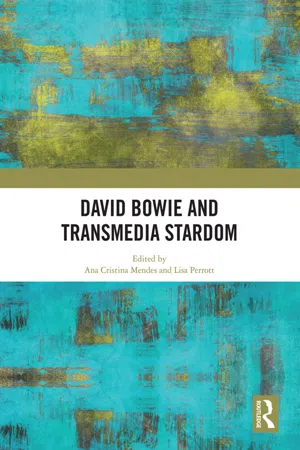
David Bowie and Transmedia Stardom
- 158 pages
- English
- ePUB (mobile friendly)
- Available on iOS & Android
David Bowie and Transmedia Stardom
About this book
Addressing the interart, intertextual, and intermedial dimensions of David Bowie's sonic and visual legacy, this book considers more than five decades of a career invested with a star's luminosity that shines well beyond the remit of pop music.
The book approaches the idea of the star David Bowie as a medium in transit, undergoing constant movement and change. Within the context of celebrity studies, the concept of stardom provides an appropriate frame for an examination of Bowie's transmedial activity, especially given his ongoing iconic signification within the celestial realm. While Bowie has traversed many mediums, he has also been described as a medium, which is consistent with the way he has described himself. With contributions from a wide range of disciplinary areas and countries, each chapter brings a fresh perspective on the concept of stardom and the conceptual significance of the terms 'mediation' and 'navigation' as they relate to Bowie and his career.
Containing a multitude of different approaches to the stardom and mediation of David Bowie, this book will be of interest to those studying celebrity, audio and visual legacy, and the relationships between different forms of media. It was originally published as a special issue of Celebrity Studies.
Frequently asked questions
- Essential is ideal for learners and professionals who enjoy exploring a wide range of subjects. Access the Essential Library with 800,000+ trusted titles and best-sellers across business, personal growth, and the humanities. Includes unlimited reading time and Standard Read Aloud voice.
- Complete: Perfect for advanced learners and researchers needing full, unrestricted access. Unlock 1.4M+ books across hundreds of subjects, including academic and specialized titles. The Complete Plan also includes advanced features like Premium Read Aloud and Research Assistant.
Please note we cannot support devices running on iOS 13 and Android 7 or earlier. Learn more about using the app.
Information
Constellating stardom, Berlin-style: Bowie, Christiane F, Hedi Slimane
ABSTRACT
Bowie and Berlin
Bowie, Slimane, Christiane F
Table of contents
- Cover
- Half Title
- Title Page
- Copyright Page
- Contents
- Citation Information
- Notes on Contributors
- Introduction: Navigating with the Blackstar: the mediality of David Bowie
- 1 Constellating stardom, Berlin-style: Bowie, Christiane F, Hedi Slimane
- 2 Football, fashion and unpopular culture: David Bowie’s influence on Liverpool Football Club casuals 1976–79
- 3 Celebrity conferences as confessional spaces: the aca-fan memory traces of David Bowie’s stardom
- 4 Is Bowie our Kierkegaard?: A theory of Agency in Fandom
- 5 ‘Oh man, I need TV when I got T. Rex’: Bowie and Bolan’s otherworldly carnivalesque intermediality
- 6 Telling lies: the interviews of David Bowie
- 7 Transition transmission: media, seriality and the Bowie-Newton matrix
- 8 Time is out of joint: the transmedial hauntology of David Bowie
- 9 ‘Look up here, I’m in heaven’: how visual and performance artist David Jones called attention to his physical death
- Index